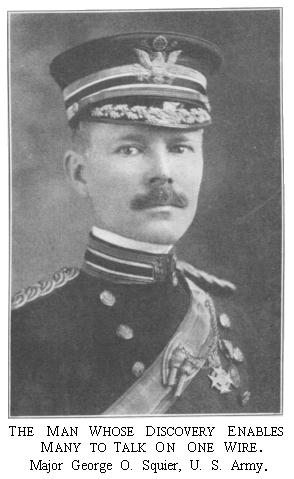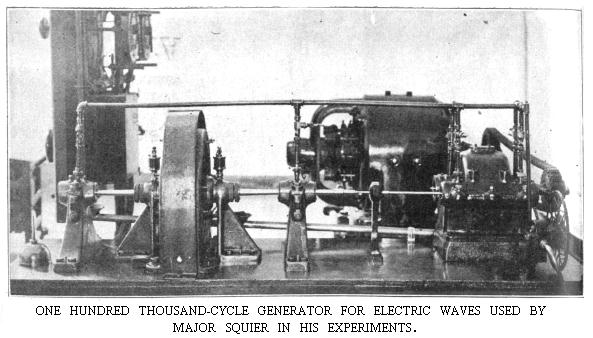Technical World Magazine, March, 1911, pages 32-35:
M A N Y T A L K O N O N E W I R E
B y
R E N É B A C H E
"HELLO! Is this New York?"

"Yes."
"This is Honolulu, in the Hawaiian Islands. Give me the Flatiron Building."
That is the sort of long-distance telephoning we shall soon be able to do. Indeed, there is every prospect that within a short time people will talk from Chicago to London over a wire. We may even send a whisper direct from Boston to Peking, China, or actually transmit a spoken message around the world!
All of this as the result of an invention just patented by Major George O. Squier, of the Signal Corps, United States Army. He has made a free gift of it, however, to the American people, and anybody is at liberty to use it without paying a cent for the privilege.
The invention does not merely promise to provide a means whereby one may telephone for a distance almost indefinite. It also makes practicable the employment of a single wire for the simultaneous sending of a number of messages, whether by the voice or by the telegraph.
Briefly described, the method adopted is one whereby wireless messages are sent over a wire--a sort of "wire wireless," as Major Squier calls it. A paradox, one might say. But the matter will be better understood when it is explained that the messages travel not through the wire itself, but through a thin layer of ether surrounding the wire. All that the wire does is to act as a guide.
Everybody is familiar with the enormously tall poles erected for wireless telegraphy. Such an "antenna," as it is called, sends out electro-magnetic vibrations which expand like the circles made by a stone which a small boy throws into a pond. It follows, of course, that their effect at any particular distant place is relatively infinitesimal. But if all of these vibrations were bunched together and sent in a single direction, it is obvious that they could be rendered a million times more efficient, so far as the carrying of vibrations to a given point is concerned.
Now, this is exactly what is accomplished by the invention here described, which, by the way, does not require the use of any new apparatus whatever. The ordinary telephonic outfit, as it exists today, may be used, without the addition of a single instrument. What Major Squier has patented is merely a new method, by which it is practicable to send extra conversations by the wire.
At the bottom of the idea upon which the invention is based lies the fact that the electro-magnetic rays which pass over a telephone wire are audible only within definite limits of frequency. If the vibrations are fewer than sixteen to the second, they transmit no impression to the human ear. On the other hand, if they number more than 20,000 to the second, the human auditory apparatus is unable to respond to them, and so perceives nothing. In other words, our ears are deaf to vibrations above 20,000 per second, and below sixteen vibrations.
To carry his messages, Major Squier employs high-frequency waves, far above the limit of human hearing. Obtaining them from a dynamo, he tunes them to various pitches, so that each conversation carried on over the wire is based upon a separate and particular number of vibrations per second. Inasmuch as the talks are on different electrical tunes, they do not interfere with one another in the least.
It will be understood, then, that high-frequency waves, suitably tuned, are traveling along the telephone wires--not in the wire itself, but in a layer of ether surrounding it. They cannot be called sound waves, because they are too rapid to produce an impression upon the human ear. Major Squier calls them "ultra-sound vibrations." Nevertheless, each voice that speaks into the transmitter affects these waves differently, and every spoken word is faithfully carried by them. When, therefore, at the other end of the line, they are retranslated back into sound waves, the message becomes audible to the listener.

Instead of an ordinary direct current through the wire itself, impulses are sent along it in the shape of high-frequency waves which, as the inventor says, "don't get into the wire at all." If it be asked how many "extra conversations" can be put on the conductor, the only possible answer is "several," because the number must depend upon the diameter of the wire and other conditions.
As the frequency of the electro-magnetic waves increases, their energy appears to have a steady growing tendency to get out of the wire itself. The ordinary battery telephonic current is largely a conduction current through metal, and the ohmic resistance of the wire is one of the principal obstacles to long-distance telephoning. On the other hand, in wireless telegraphy, frequencies from 100,000 up to several millions per second are used, and the energy is chiefly radiated into the ether of space.
There is, however, an intermediate range, in which the vibrations are from 20,000 to 100,000 per second, and where-in the electro-magnetic energy is still sufficiently linked to the wire to prevent excessive radiation into the ether. The wire, while carrying but a small part of the energy, nevertheless acts as an efficient guide for the high-frequency waves. Accordingly, use is made of these steered ether waves as a vehicle to carry telephonic or telegraphic messages.
It will thus be seen that the new invention combines the principles of wireless telegraphy and telephony with those of telegraphy and telephony by wire. Major Squier, in other words, has taken the apparatus and methods now used in wireless communication, and has applied them to the transmission of electro-magnetic waves along metal conductors, thus accomplishing an enormous improvement in efficiency over the plan of employing antennæ at transmitting and receiving stations, which is the ordinary custom.
The circuits are ordinary telephonic circuits, such as are now utilized in wire telephony and telegraphy. "In fact," says the inventor, "the regular twisted-pair paper-insulated lead-covered telephone cable serves the purpose very well, the energy being conveyed principally in the minute layer of ether separating the two metallic conductors. By this means a most efficient system of high-frequency telephony or telegraphy is maintained, and, at the same time, any interferences between neighboring circuits operated by the system are eliminated, so that many such circuits may be brought to the same switchboard without interfering effects."
The inventor further says: "Since a plurality of high-frequency waves of different frequencies may be impressed on the same line, and since these may be selectively separated from each other by suitably tuned circuits, it is obvious that multiplex telephony is practicable. Also, it has been found that these high-frequency waves may exist on the same line with ordinary battery telephonic currents without in any way affecting them; and thus the system may be applied to the usual telephonic circuit without 'cross talk' or other disturbances."
Major Squier calls attention to the fact that it is almost impossible to make an ordinary telephonic system work satisfactorily over any circuit that is connected with the ground. Lines with such circuits are subject to serious difficulties, chief among which are the strange noises heard in the receiving instruments. The cause of these noises, by the way, is not very well understood. But the new plan makes it practicable to connect a telephone circuit with the earth at both ends without inviting the slightest suggestion of such disturbances--a very important feature of the invention, in Major Squier's own opinion.

The high-frequency telephonic messages and the local battery messages may exist on the line simultaneously without a trace of any "cross-talk" or disturbing noises from other external sources. Earth or ground connections form a part of the tuned circuit, and no noises from the earth are permitted to pass, because all such ground connections are tuned to frequencies far above the human auditory limit.
Very essential is the fact that the condensers used are of a capacity so small as to be measured in terms of thousandths of a microfarad, and they block all currents of such low frequencies as the ordinary telephonic currents, or those which bring disturbing noises from external sources.
The whole range of electro-magnetic vibrations is viewed by Major Squier as a spectrum extending from the ultra-violet, which is a region of high frequencies, to the exceedingly slow oscillations of the infra-red, such as are used on long-distance submarine cables. One might say that these are terms of light; and so, indeed, they are. But, as the inventor explains, light and electricity are the same thing. Vibrations within certain limits of frequency, as already stated, can be heard over a wire. Above 20,000 a second they become inaudible to the human ear. When they have got to 700,000,000,000,000 to the second, they become visible to the eye. We could actually see telegraphic messages, instead of hearing them, if our eyes were suitably constructed.
The waves used by Major Squier belong to the great unexplored region which lies above the limit of audibility and below the limit of visibility. They can be neither heard nor seen; yet they are utilized for purposes of wireless telegraphy, and those of them which are relatively low down in the scale of frequency can be employed to carry messages.
All the vibrations being bunched together and guided by the wire in a single direction, they can be sent to an enormously greater distance. Hence, the likelihood that long-distance telephones operated on the new principle will be able to carry messages across the ocean and even, if desired, around the world.
Such, briefly described, is the novel idea which seems destined to revolutionize telegraphy as well as telephony; for it is as applicable to the former as to the latter. It ought greatly to cheapen both. But Major Squier seems to think that one of the most important advantages of his discovery lies in the fact that it can be utilized and applied with the apparatus already in common employment. Its application does not demand a single instrument that cannot be purchased for a moderate price in the open market--for which reason it is at the service not merely of the telephone and telephone companies, but of any private citizen. It is the property of the people.
All of the experiments with the multiplex telephone up to date have been conducted over a single circuit, which connects the research laboratory of the Signal Corps--at the Bureau of Standards--with the construction laboratory of the Signal Corps. on Pennsylvania Avenue, close by the War Department, in Washington. The distance between the two points is about five miles. Over this line the new system is now in operation.


